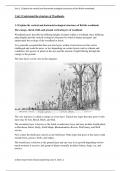Unit 1.1 Explain the vertical and horizontal ecological structures of the British woodland.
Unit 1 Understand the structure of Woodlands.
1.1 Explain the vertical and horizontal ecological structures of British woodlands.
The canopy, shrub, field, and ground vertical layers of woodland.
Woodland layers describe the differing heights of plants within a woodland, these differing
plant heights provide vertical ecological structures by which a human navigates and
understands the ecology of the woodland or forest.
It is generally accepted that there are four layers within a forest however this can be
challenged and could be more, or less depending on certain factors such as climate and
conditions, the species of plants in the area and the amount of light filtering through the
canopy to the ground.
The four layers can be seen in this diagram:
The very top layer is called a canopy or a tree layer. Typical tree types that may grow in this
layer may be Ash, Beech, Birch, and Oak.
The secondary layer is known as the shrub or understory layer and may include should plants
as Hawthorn, Hazel, Holly, Field Maple, Rhododendron, Rowan, Wild cherry and Wild
service.
Next comes the third layer, known as the field layer. Plant types that grow at this layer could
include ferns, grasses, herbs, and sedges.
The fourth layer is known as the ground layer and can vary in its growth depending on how
much moisture it receives, this group of plants normally includes lichens, fungi, ivy, and
mosses.
Jo Benn-Day Forest School Leadership Level 3. Unit 1.1
, Unit 1.1 Explain the vertical and horizontal ecological structures of the British woodland.
The horizontal layers are focused specifically on the different points or stands found within a
woodland or forest. Consideration needs to be given as to whether a woodland has been
planted or self-set, tree density: high or low, what is the human or animal impact, space and
gaps and their impact.
Other factors affecting horizontal layers may include the depth and moisture level of the soil,
fire, presence of rocks, rivers or bodies of water and plant disease or the presence of other
plants both natural and invasive. (Please refer to diagram below):
The scrub, pioneer stages of woodland along with glades.
Scrub is often found where woodlands start, end or where woodland may develop. Generally,
scrub is a mixture of shrubs and bushes which may include plants such as bramble,
blackthorn, and hawthorn, which have many stems and grow to a height of 4 to 5 metres, this
in turn may grow into a canopy. These type of scrub plants are part of the pioneer species of
plants which can grow and colonise open habitats rather rapidly.
Heathland, grassland, or disused farmland, which are no longer maintained, cut, or grazed are
the spaces and places where it is possible for scrub to establish itself relatively quickly, it is
likely that a canopy may begin to form over the scrub once it is firmly established.
Pioneer species are hardy plant species that have evolved to grow and colonise in biodiverse
ecosystems, examples of which include moss and lichen. These pioneer species are able to
live on surfaces such as rocks which are devoid of soil. They grow in harsh conditions where
there is little competition from other plants.
Pioneer plants are the plants which create a place for invertebrates , such as worms and bees,
to live. These plants enable the humus level to increase and retain water. Pioneer plants use
the wind to disperse their seeds and spores.
Jo Benn-Day Forest School Leadership Level 3. Unit 1.1




